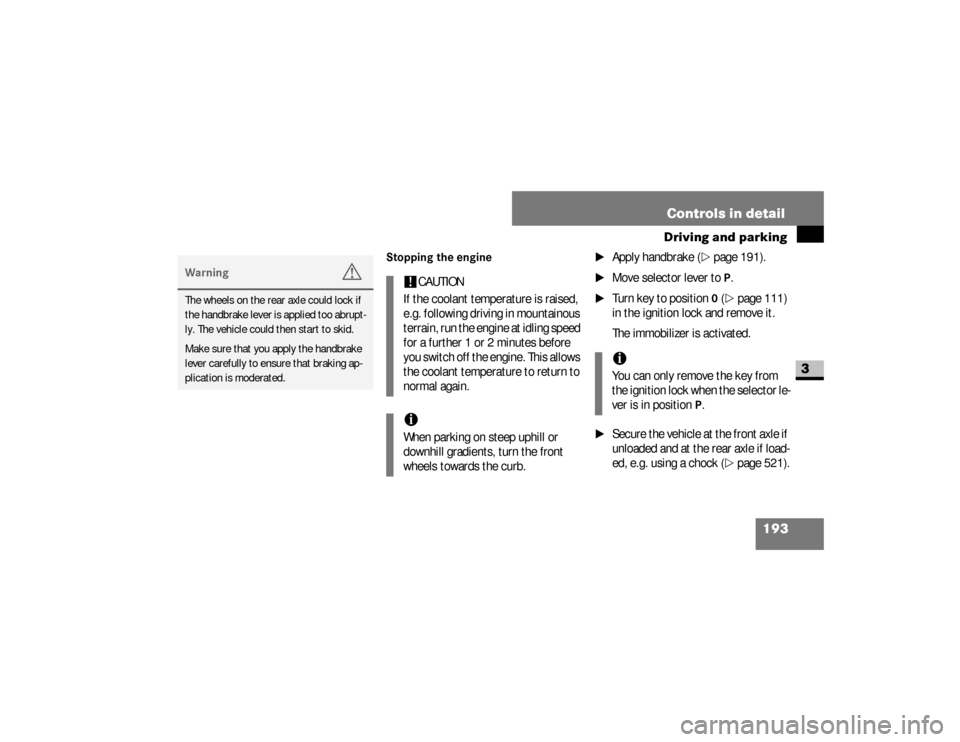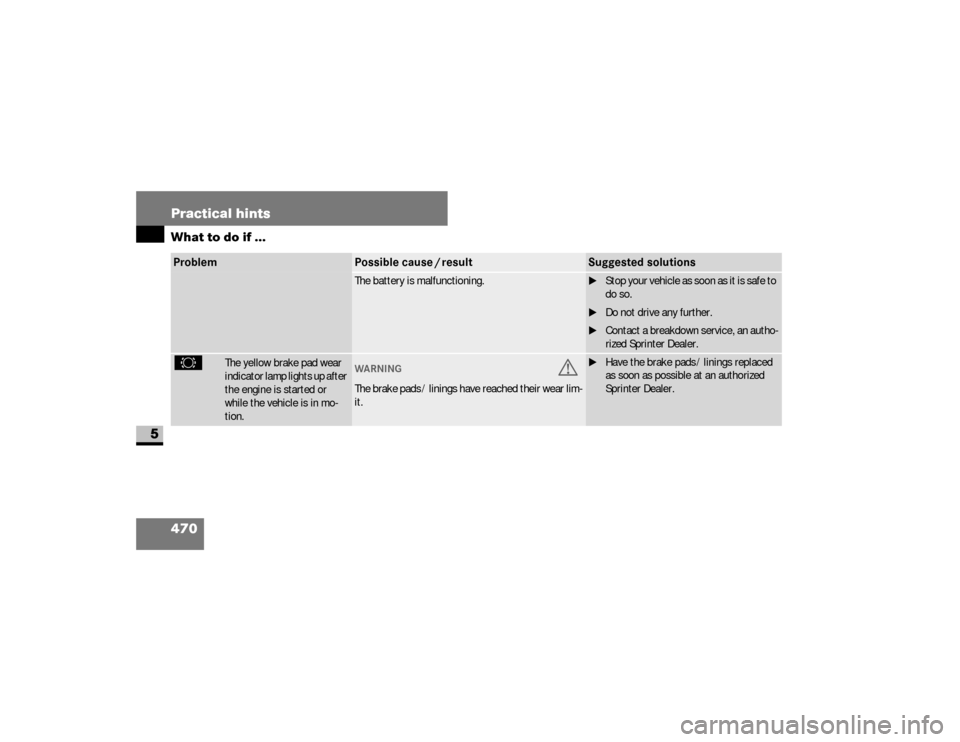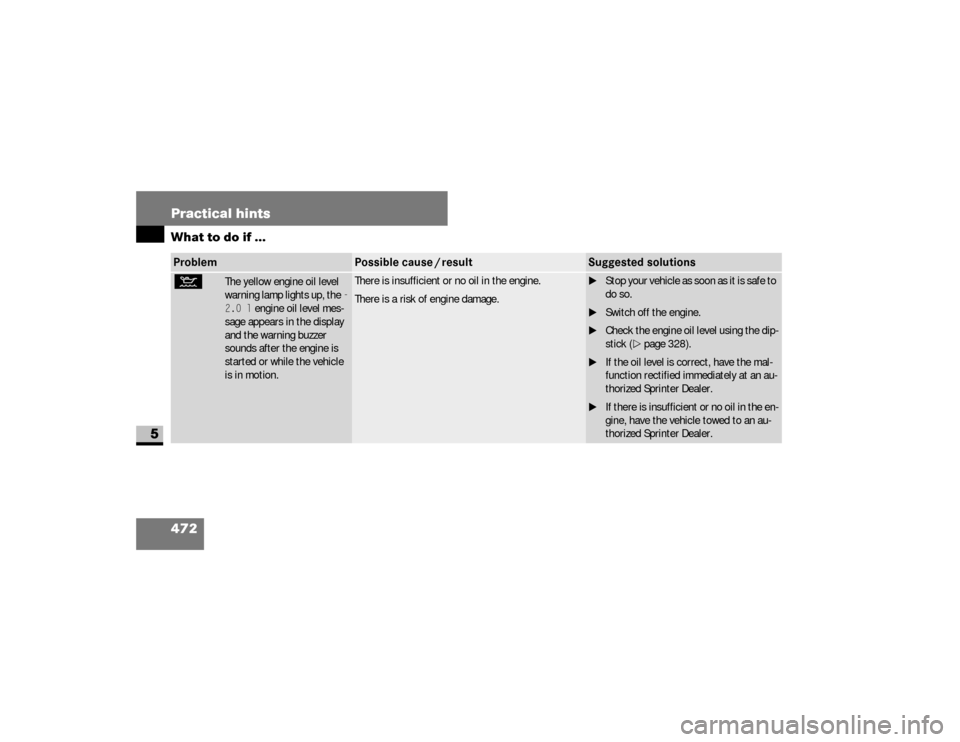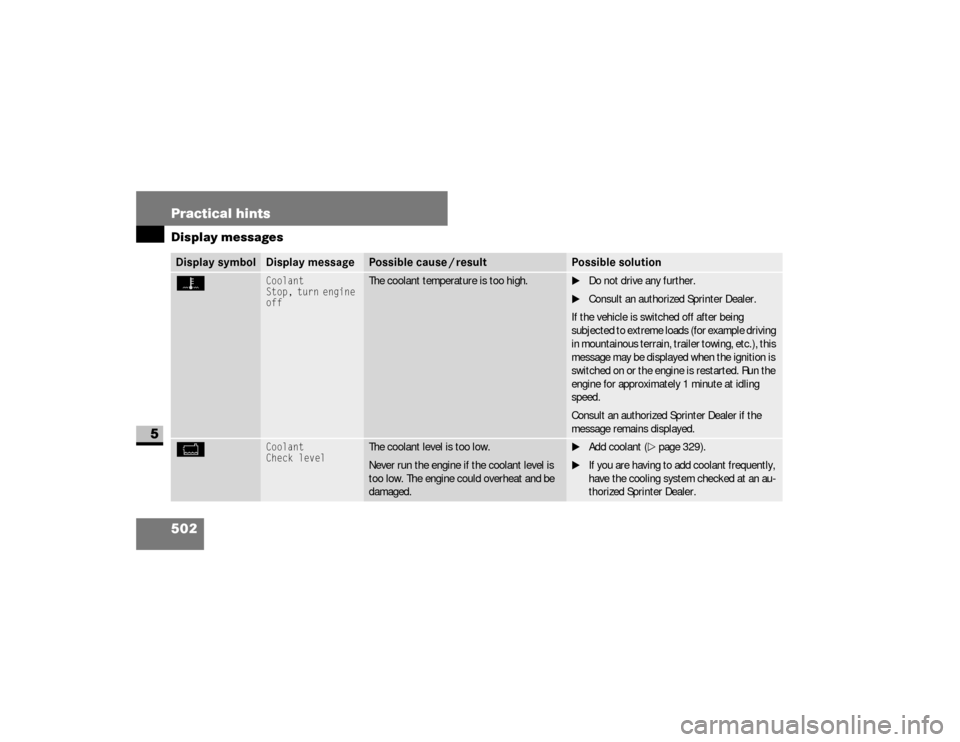stop start DODGE SPRINTER 2008 2.G Owners Manual
[x] Cancel search | Manufacturer: DODGE, Model Year: 2008, Model line: SPRINTER, Model: DODGE SPRINTER 2008 2.GPages: 666, PDF Size: 14.11 MB
Page 195 of 666

193 Controls in detail
Driving and parking
3
Stopping the engine\1
Apply handbrake (
\2
page 191).
\1
Move selector lever to
P.
\1
Turn key to position
0 (\2
page 111)
in the ignition lock and remove it.
The immobilizer is activated.
\1
Secure the vehicle at the front axle if
unloaded and at the rear axle if load-
ed, e.g. using a chock (
\2
page 521).
Warning
G
The wheels on the rear axle could lock if
the handbrake lever is applied too abrupt-
ly. The vehicle could then start to skid.
Make sure that you apply the handbrake
lever carefully to ensure that braking ap-
plication is moderated.
!
CAUTION
If the coolant temperature is raised,
e.g. following driving in mountainous
terrain, run the engine at idling speed
for a further 1 or 2 minutes before
you switch off the engine. This allows
the coolant temperature to return to
normal again.
iWhen parking on steep uphill or
downhill gradients, turn the front
wheels towards the curb.
iYou can only remove the key from
the ignition lock when the selector le-
ver is in position
P.
nf_BA.book Page 193 Friday, January 25, 2008 3:53 PM
Page 311 of 666

309 Operation
Driving tips
4
Towing a trailerThere are many different laws, including
speed limit restrictions, having to do
with trailer towing. Make sure that your
vehicle-trailer combination will be legal,
not only for where you reside, but also
for where you will be driving. A good
source for this information can be the
police or local authorities.
Before you start driving with the trailer,
check the trailer hitch, break-away
switch, safety chains, electrical connec-
tions, lighting and tires. Also adjust the
mirrors to permit an unobstructed view
beyond the rear of the trailer.If the trailer has electric brakes, start
your vehicle and trailer moving slowly,
and then apply only the trailer brake
controller by hand to be sure that the
brakes are working properly.
When towing a trailer, check occasional-
ly to be sure that the load is secure, and
that lighting and trailer brakes (if so
equipped) are functioning properly.
Always secure items in the trailer to pre-
vent load shifts while driving.
Take into consideration that when tow-
ing a trailer, the handling characteristics
are different and less stable from those when operating the vehicle without a
trailer. It is important to avoid sudden
maneuvers.
The vehicle and trailer combination is
heavier, and therefore is limited in accel-
eration and climbing ability, and requires
longer stopping distances. It is more
prone to reacting to side wind gusts, and
requires more sensitive steering input.
In order to gain skill and an understand-
ing of the vehicle’s behavior, you should
practice turning, stopping and backing
up in an area which is free from traffic.
nf_BA.book Page 309 Friday, January 25, 2008 3:53 PM
Page 322 of 666

320 OperationEngine compartment
4
Closing
Warning
G
Engine parts may be hot and can rotate.
There is a risk of injury if the hood is open
and the engine is running.
Only open the hood when the engine has
stopped and cooled down.
Warning
G
The engine has an electronic ignition sys-
tem which carries a high voltage. For this
reason, you must never touch the ignition
system components (ignition coil, test
socket) while:
\4the engine is running
\4the engine is being started
\4the key is in position2 in the ignition
lock and the engine is being cranked
by hand
Warning
G
Make sure that nobody can become
trapped as you close the hood.
nf_BA.book Page 320 Friday, January 25, 2008 3:53 PM
Page 372 of 666

370 OperationTires and wheels
4
Warning (Continued)
G
As an added safety feature, your vehicle
has been equipped with a Tire Pressure
Monitoring System (TPMS) that illumi-
nates a low tire pressure telltale when one
or more of your tires is significantly under-
inflated. Accordingly, when the low tire
pressure telltale illuminates, you should
stop and check your tires as soon as pos-
sible, and inflate them to the proper pres-
sure. Driving on a significantly
underinflated tire causes the tire to over-
heat and can lead to tire failure.
Continued
Warning (Continued)
G
Underinflation also reduces fuel efficiency
and tire tread life, and may affect the ve-
hicle’s handling and stopping ability.
Please note that the TPMS is not a substi-
tute for proper tire maintenance, and it is
the driver’s responsibility to maintain cor-
rect tire pressure, even if underinflation
has not reached the level to trigger illumi-
nation of the TPMS low tire pressure tell-
tale.
Continued
Warning (Continued)
G
USA only:Your vehicle has also been equipped with a
TPMS malfunction indicator to indicate when
the system is not operating properly. The
TPMS malfunction indicator is combined
with the low tire pressure telltale. When the
system detects a malfunction, the telltale will
flash for approximately 1 minute and then re-
main continuously illuminated. This se-
quence will continue upon subsequent
vehicle start-ups as long as the malfunction
exists. When the malfunction indicator is illu-
minated, the system may not be able to de-
tect or signal low tire pressure as intended.
Continued
nf_BA.book Page 370 Friday, January 25, 2008 3:53 PM
Page 428 of 666

426 OperationCleaning and care of the vehicle
4
\1
Clean the vehicle, particularly the
lighting equipment, windows, exteri-
or mirrors, steps, entrances, grab
handles, wheels, tires, wheel hous-
ings and license plates. Observe the
notes in this section.
\1
Remove any trapped foreign objects,
e.g. stones.
Warning (Continued)
G
Risk of skiddingDirt and mud on the tires / road surface
reduce wheel grip. This is especially so if
the road surface is wet. The vehicle could
then start to skid.Risk of slippingDirt and mud on the steps and entrances
make the steps less safe. As a result you
could slip from the steps and injure yourself.For this reason, always clean your vehicle
carefully after driving off-road and on con-
struction sites before using public roads.
Continued
Warning (Continued)
G
If you use a high-pressure cleaner or auto-
matic car wash for this purpose, you must
follow the relevant safety instructions in
this section.
Warning
G
Dirty brake discs and brake pads / linings
can impair braking power (to the point of
total failure).You could thereby cause an accident.Check the brake system for operating
safety by testing the brakes before driving
the vehicle onto public roads.If braking power is impaired, stop the ve-
h i c l e a s s o o n a s i t i s s a f e t o d o s o a n d c o n -
sult an authorized Sprinter Dealer which
has the necessary specialist knowledge
and tools to carry out the work required.
Continued
nf_BA.book Page 426 Friday, January 25, 2008 3:53 PM
Page 443 of 666

441 Practical hints
What to do if ...
5
Problem
Possible cause / result
Suggested solutions
The transmission no longer changes gear cor-
rectly.
The transmission is losing oil.
\1Have the transmission checked imme-
diately at an authorized Sprinter Dealer.
The acceleration ability is deteriorating.
The transmission does not shift.
The transmission is in emergency mode.
It is only possible to shift into second gear or re-
verse gear.
\1Stop the vehicle.
\1Move the selector lever to positionP.
\1Switch off the engine.
\1Wait at least 10 seconds before restart-
ing the engine.
\1Move the selector lever to positionD or
R.
\1In positionD, the transmission shifts
into second gear; in positionR, the
transmission shifts into the reverse
gear.
\1Have the transmission checked imme-
diately at an authorized Sprinter Dealer.
nf_BA.book Page 441 Friday, January 25, 2008 3:53 PM
Page 472 of 666

470 Practical hintsWhat to do if ...
5
The battery is malfunctioning.
\1Stop your vehicle as soon as it is safe to
do so.
\1Do not drive any further.
\1Contact a breakdown service, an autho-
rized Sprinter Dealer.
2
The yellow brake pad wear
indicator lamp lights up after
the engine is started or
while the vehicle is in mo-
tion.
WA RNING
G
The brake pads / linings have reached their wear lim-
it.
\1Have the brake pads / linings replaced
as soon as possible at an authorized
Sprinter Dealer.
Problem
Possible cause / result
Suggested solutions
nf_BA.book Page 470 Friday, January 25, 2008 3:53 PM
Page 474 of 666

472 Practical hintsWhat to do if ...
5
:
The yellow engine oil level
warning lamp lights up, the
-
2.0 l
engine oil level mes-
sage appears in the display
and the warning buzzer
sounds after the engine is
started or while the vehicle
is in motion.
There is insufficient or no oil in the engine.
There is a risk of engine damage.
\1Stop your vehicle as soon as it is safe to
do so.
\1Switch off the engine.
\1Check the engine oil level using the dip-
stick (\2page 328).
\1If the oil level is correct, have the mal-
function rectified immediately at an au-
thorized Sprinter Dealer.
\1If there is insufficient or no oil in the en-
gine, have the vehicle towed to an au-
thorized Sprinter Dealer.
Problem
Possible cause / result
Suggested solutions
nf_BA.book Page 472 Friday, January 25, 2008 3:53 PM
Page 504 of 666

502 Practical hintsDisplay messages
5
Z
Coolant
Stop, turn engine
off
The coolant temperature is too high.
\1Do not drive any further.
\1Consult an authorized Sprinter Dealer.
If the vehicle is switched off after being
subjected to extreme loads (for example driving
in mountainous terrain, trailer towing, etc.), this
message may be displayed when the ignition is
switched on or the engine is restarted. Run the
engine for approximately 1 minute at idling
speed.
Consult an authorized Sprinter Dealer if the
message remains displayed.
H
Coolant
Check level
The coolant level is too low.
Never run the engine if the coolant level is
too low. The engine could overheat and be
damaged.
\1Add coolant (\2page 329).
\1If you are having to add coolant frequently,
have the cooling system checked at an au-
thorized Sprinter Dealer.
Display symbol
Display message
Possible cause / result
Possible solution
nf_BA.book Page 502 Friday, January 25, 2008 3:53 PM
Page 564 of 666

562 Practical hintsFlat tire
5
\1
Start the engine (
\2
page 186).
\1
Press
I on electric air pump
switch1
.
The electric air pump is switched on.
The tire sealant is then pumped into
the tire and the tire pressure is in-
creased. Allow the electric air pump
to run for at least 10 minutes until tire sealant bottle
8
is completely
empty and a minimum tire pressure
of 43.5 psi (3.0 bar) is achieved.
\1
Inflate the tire using the electric air
pump until the recommended tire
pressure (
\2
page 361) is achieved.
\1
Then press
0 on electric air pump
switch
1
.The electric air pump is switched off.
\1
Slide knob
a
quickly to the stop in
valve core extractor
c
.
\1
Turn knob
a
clockwise until the
valve core is firmly screwed into tire
valve
d
.
!
CAUTION
Do not connect the electric air pump
connector to the cigarette lighter
socket or another 12 V socket. These
are not designed for operating the
electric air pump.
!
CAUTION
Do not run the electric air pump for
more than 20 minutes without a
break, otherwise it may overheat.
The air pump can be used again once
it has cooled down.
iDo not pull the valve core extractor
from the tire valve while the valve
core is unscrewed from the tire
valve. Tire sealant could otherwise
escape onto your hands.
The tire sealant is water soluble. If
tire sealant escapes, you can wash it
away with water.
nf_BA.book Page 562 Friday, January 25, 2008 3:53 PM